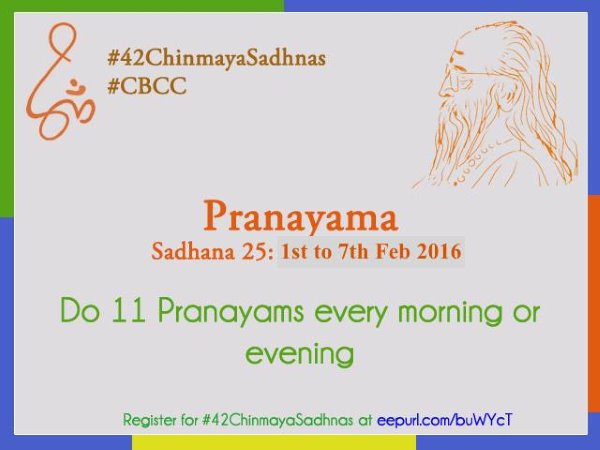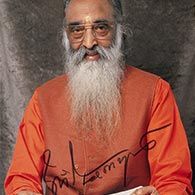Sadhana for Week 25
Body Level: Pranayama
Do 11 Pranayams every morning or evening

Quote:
Yoga may, in its processes, make use of the physical structure (body),
But its main goal is the development of the mind and intellect.
The mind has to be raised step by step,
From the gross state to the subtle state;
Then to the causal state
And still further to the great cause,
And thus finally to Samadhi.
Anecdote:
Once Poojya Gurudev Swami Chinmayanandaji’s address book was lost and the secretary was very disturbed. When Swamiji came to know about it, he told him to sit down and dictated the addresses of 1000+ people. One of the members of Chinmaya Yuva Kendra Mumbai was present there and asked Poojya Gurudev, what was the secret of his memory and he said – Brahmacharya.
What is Prana?
From time immemorial, wise men, rishis and sages have taught their disciples that there is to be found in the air, a substance from which all life emanated. This force or substance is Prana – the energy, the essence of life or the universal force.
Prana is in the air, but it is not air, nor one of the constituents of air, nor oxygen. We mainly experience Prana through breathing. It is the vital energy, the cosmic energy which is present in all 5 elements – air, water, fire, food and space. Pranic energy is there in everything; sunlight, air, food, water, beings, etc
All animals, plants, human beings etc. breathe this Prana in, with the air. Our physical system takes in oxygen along with Prana.
Pra?ayama is a Sanskrit word meaning "control of the life force". The word is composed from two Sanskrit words: Prana means life force (often misunderstood and restricted to mean the breath), and ayama, to extend or draw out. (Not "restrain, or control" as is often translated from yam instead of ayama).
Pranamaya-Kosha (Vital Air Sheath)
For every action that we do, we spend prana- Vital energy.
This Pranamaya Kosha or Vital Air Sheath links the food sheath – the annamaya kosa (the body) and the other three sheaths(mind, intellect, bliss). Upon death, the mind departs along with the prana from the body.
Yoga also says that our life span is fixed by the no. of breaths we are destined to breathe as per our Karma. The shallower one breathes, the shorter is one’s life. The deeper and steadier one breathes, longer is one’s life. Sparrow breathes very fast and dies soon. Dog breathes a bit slower and lives longer. Tortoise breathes the slowest and deepest and lives the longest.
For good health, one must breathe deeply. Otherwise, lots of air bags in the lungs go unused and start housing bacteria and germs which make us sick when our resistance becomes weak.
Pranayama
The energy in the body is because of Prana. Prana expresses in the body through 5 physiological functions:
1. Prana Vayu (faculty of Respiration)– all that we take in ie through food, deep breath, through water, etc.
2. Apana (faculty of excretion) – all that which we throw out ie water, waster, breath
3. Vyana (faculty of circulation) – circulation of blood and thus the nourishment of organs and cells
4. Udana (faculty of reverse processes) – vomiting, hiccups, sweating. Also regulates the movement of the subtle body out of the gross body at the time of death. Is also responsible for the creativity in person, all artists have a strong udana.
5. Samana (faculty of digestion) – digestion and assimilation of all food and liquids taken in.
Pranayama is not swasayama (control of breath). It is the control of all the physiological systems of the body through the practice of breath control & self-control.
By controlling the motion of lungs or respiratory organs, we can control the Prana that is vibrating inside. By control of Prana, the mind can be easily controlled, because the mind is fastened to the Prana. Similarly if the mind is controlled the prana too can be regulated.
Thus pranayama is considered as a very important Sadhana to gain control of the mind. There are yogis who are able to tap pranic energy from the 5 elements in such a way that they do not require food at all. They tap it from sunlight, air and water. Pranayama or the control of Prana is that means by which the Yogi tries to realize or attain Perfection by making the entire personality quiet.
Pranayama occupies a very important place in our culture. Before one eats, drinks, resolves to do anything, Pranayama should be performed first and then the nature of his/her determination should be clearly enunciated and placed before the mind. The fact of its preceding every effort of the will is a surety that, that effort will be crowned with success and the mind will be directed to bring about the desired result.
Pranayama is the intelligent use of Prana. Some ways are given below:
1. One must breathe deeply as much as possible. Early morning, try to take atleast 20-25 slow and deep breaths. If one can do pranayama, it will be the best. But pranayama must be done only under the guidance of a qualified teacher.
2. Take a break in the afternoon from the work, for 3-5min. Breathe deeply. It will relax the body and quieten the mind too.
3. Prana – energy must be conserved and not wasted.
Meditation is the highest vocation and it requires the maximum energy. To sit erect, without movement, for long hours, is not easy. To fight the impurities of the mind also requires tremendous energy.
4. Through Pranayama – special breathing technique, we take in more of Prana – energy and also save the wastage of energy.
5. By indulgent living we drain our energy physically and mentally also we become very weak. We lose the stamina to fight the impurities of the mind.
6. To save one’s energy the scriptures advocate the concept of Brahmacharya – Celibacy. Brahmacharya is the attitude of intelligent contact with the world outside from the flesh-level i.e the body. It is not merely absistence from carnal pleasure.
Our senses continuously seek gratifications in the sensual objects.
When we live seeking gratification of the sensual desires, passions breed and they consume the man totally. To avoid self-afflicted ills, Brahmacharya is prescribed at the physical level. It is to live in self control with respect to all our sense enjoyments and does not mean their total denial. Objects are meant for us to enjoy. Brahmacharya is to help us in enjoying the objects. Otherwise, the objects enjoy us. The Rishis say: Eat the food. Let not the food eat you. Drink, let not the drink drink you.
Brahmacharya is popularly understood to be only absistence from carnal pleasure. But it has deeper implications. Brahmacharya is to abstain from excessive indulgence in any sensual pleasure.
To talk too much, to be addicted to TV or radio, or even computers etc. is violation of Brahmacharya. Any addiction or excessive indulgence is violation of Brahmacharya.
How to?
1. Sit erect. The head, the neck and spine in a straight line. Come to a comfortable posture.
2. Exhale all the air. Exhalation is called Rechak. Cover your left nostril with the thumb of the left hand and take a deep breath through the right nostril. This deep breath is called Purak. Close the right nostril with the small and ring finger of the left hand and hold the breath. This holding is called kumbhak. After a few seconds, release your thumb and exhale through the left nostril. Hold the breath for a few seconds. Now inhale through the left nostril, close it with the thumb, hold the breath for a few seconds and exhale through the right nostril.
3. In short:
Exhale with both nostrils and after that, follow the process given below:.
Inhale with the right nostril (Purak)
Hold the breath (Antah Kumbhak)
Exhale with the left nostril (Rechak)
Hold the breath (Bahish kumbhak)
Inhale with the left nostril (Purak)
Hold the breath (Antah Kumbhak)
Exhale with the right nostril (Rechak)
Hold the breath (Bahish Kumbhak)
Follow this process. It is called Anuloma-Viloma Pranayama.
4. If anyone is a heart patient or BP patient etc. then please do not hold the breath. Skip the step of Kumbhak.
5. Generally, Pranayama experts practice this in the ratio of 1:4:2:2 for inhalation, retention, exhalation & retention respectively. But this should be learnt and performed under guidance and training.
Benefits:
1. Improves metabolism
2. Conserves energy
3. Calms the mind, makes it single pointed and ready for meditation
4. Reduces stress
5. Helps to reduce weight
6. Increases appetite
7. Increases physical strength and courage
8. Cheerful disposition and enthusiasm
Beginners and Advanced:
Beginners:
1. Practice the Anuloma-Viloma Pranayama 11 to 15 times a day morning and/or evening.
Advanced seeker:
1. If you are an expert in practicing Pranayama, you can chant Om or Gayatri Mantra while the breath is retained. Many yogis contemplate on the Self through these mantras and attain the state of Samadhi because the Body, Breath, mind…Ego – all are still in the state of retention of the breath.
2. In a text called Aparokshanubhuti, Sri Adi Shankaracharya gives the Vedantic vision of Pranayama in verses 118 to 120.
Negation of the world of plurality is to be considered as rechaka (breathing out), continuous thought of “I am Brahman” is called Puraka (breathing in), and the steadiness in that thought thereafter is called Kumbhaka (holding the breath within). This is true pranayama to the wise, while the ignorant merely tortures his nose.
.jpg)
UNTO HIM OUR BEST


